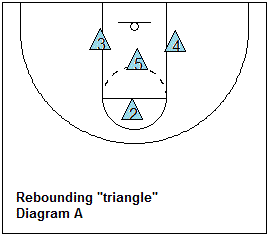Basketball Zone Defense - Rebounding Out of the Zone
By Dr. James Gels, From the Coach’s Clipboard Basketball Playbook"Helping coaches coach better..."
Disclosure: This page contains affiliate links, which means that Coach's Clipboard receives a small commission (at no cost to you) if you make a purchase using these links.
Rebounding out of a man-to-man defense is fairly straight forward, usually with clear-cut box-out assignments. But what about rebounding out of a zone defense? Defensive rebounding can be either a weakness or a strength of the zone defense. On the positive side, you can put your "bigs" inside, keep them there and rebound missed shots.
On the other hand, often there are not clear-cut box-out assignments when playing zone defense, especially when the zone is over-shifted or overloaded. Offensive players will try to penetrate the gaps in the zone, not only when trying to score, but also when rebounding. Zone defenses that don't box-out well will give up second and third shots.
Rebounding Objectives
- Fundamentals. The basic boxing-out and rebounding fundamentals are the same, whether playing zone or man-to-man defense. See Rebounding Tips, Techniques and Fundamentals.
- The defender on the ball boxes-out the shooter.
- Weak-side rebounding is extremely important, especially on long shots from the wing or corner. You are trying to force the offense to take outside shots, so be ready to rebound those shots! Someone did a study that showed that approximately 70% of missed shots from the corner go to the opposite side. So we always want a weak-side rebounder there. Some coaches teach having two players get to the weakside, the weakside forward and the weakside guard.
- Rebounding triangle. Ideally, whenever a shot is taken, the defense should try to establish an inside rebounding triangle with a rebounder on each side of the basket and one in front (see diagram A below).
Rebounders should not get too low under the basket, or else the only rebound they will get is the shot that goes through the net! If you are too far under, the offense can nudge you further under the basket and can rebound over your back without actually making enough contact to get the "over the back" foul. - We want one perimeter rebounder at about the level of the free-throw line... to get the long rebound. Again, some coaches want this player to shade more toward the weakside.
- You must have rules for your zone defensive and rebounding rotations. In most cases, the defensive and rebounding rotations (and box-out assigments) will be similar.
- Defensive rebounders should not only get to a spot, but also "find" the nearest offensive player and box-out.
Specific Zone Rebounding Rotations
You can make your own zone rebounding rotations, and these should be similar to the way you decide to rotate and cover certain areas of the court defensively... the point, high-post, wings and corners. Below are some example rotations. You may choose to do it differently.1-2-2 (or 3-2) Zone Rebounding
Diagram B shows how the 1-2-2 zone could rotate to rebound when the shot goes up from the wing. The shooter is boxed-out, your "bigs" X4 and X5 are already on the blocks, and the opposite wing drops inside to become the middle of the triangle.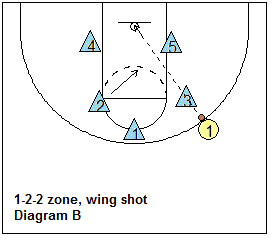
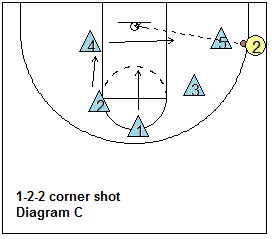
Diagram C shows the shot from the corner. Here, our ball-side post defender closes out on the shooter. The opposite post defender rotates to the ball-side block. The opposite wing defender drops to the weak-side block. The point defender X1 drops to become the middle of the rebounding triangle. We want X3 on the outside to deny or defend the next pass out to the wing.
2-3 Zone Rebounding
Diagram D shows how the 2-3 zone rotates when the shot goes up from the top. It's fairly straight forward with the "triangle" already in place, and the opposite top defender slides in to the free-throw line for the longer rebound.Diagram E shows the shot from the wing. The shooter is boxed out and again, the triangle should already be in pretty good position. The opposite wing defender again slides into the free-throw line area, or to that gap between X5 and X3, more on the weakside.
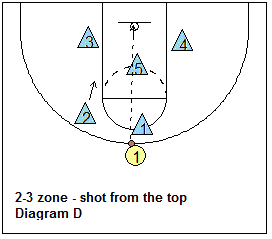
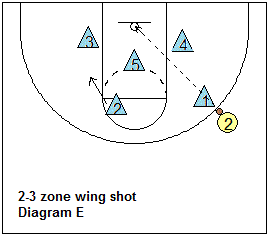
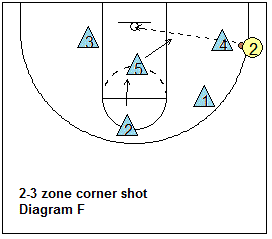
Diagram F shows the shot from the corner. Our ball-side post defender closes out on the shooter. The middle low defender rotates to the ball-side block. The opposite post defender is already in position for the weak-side rebound. The opposite wing defender drops inside to become the middle of the triangle. X1 stays on the outside to deny or defend the next pass out to the wing.
Drills
You can devise your own drills by modifying the "War Drill", putting your defenders into the zone, and then shooting the shot from specific locations... the top, the wings, the corners, shot corners, high-post, etc. Make sure defenders are rotating, "creating the triangle", and boxing out effectively. You can also just do your standard half-court zone defense 5-on-5 drills that you probably do every day, and have one of your assistants watch the rebounding and boxing-out assignments, stopping and pointing out errors.Related pages:





